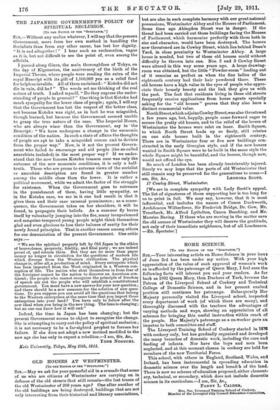OLD HOUSES AT WESTMINSTER.
[To THE-EDITOR Or THE " SPECTATOR."] SIB,—May we ask for your powerful aid in a crusade that some of ns who are citizens of Westminster are carrying on in defence of the old streets that still remain—the last traces of the old Westminster of 200 years ago P One after another of the old buildings are being destroyed, buildings that are not only interesting from their historical and literary associations, but are also in such complete harmony with our great national possessions, Westminster Abbey and the Houses of Parliament. Some time ago Abingdon Street was in danger. If the threat had been carried out those buildings facing the Houses of Parliament, which harmonize perfectly with them both in size and character, would have been destroyed. The houses now threatened are in Cowley Street, which lies behind Dean's Yard, in close proximity to Westminster Abbey. A large house is needed, but two of these old houses could without difficulty be thrown into one. Nos. 2 and 3 Cowley Street were altered in this way some years ago, A large drawing- room was obtained, but the little " Powder-room " leading out of it remains as perfect as when the fine ladies of the eighteenth century had their hair powdered there. These old houses have a high value in the eyes of people who appre- ciate their homely beauty and the link they give us with the past. The fact that residents living in these old streets frequently receive applications from house agents specially asking for the " old houses " proves that they also have a distinct commercial value.
North Street,which adjoins Cowley Street,was also threatened a few years ago, but, happily, people came forward eager to secure the pretty old houses, and to the relief of the lovers of Westminster the houses were relet on lease. Smith Square, to which North Street leads up so finely, still retains on one side houses built in the eighteenth century. There are in Westminster four or five new buildings con- structed in the early Georgian style, and if the new houses wanted in Smith Square were to be built in the same style the whole Square might be beautiful, and the houses, though new, would not offend the eye.
So much of London has been already irretrievably injured. Surely we may hope that the parts of old Westminster that still remain may be preserved for the generations to come.—I am, Sir, &c., LE ON ORA SCOTT. 17 Cowley Street, Westminster.
[We are in complete sympathy with Lady Scott's appeal. The list of signatures of those supporting her is too long for us to print in full. We may say, however, that it is most influential, and includes the names of Canon Duckworth, Archdeacon Wilberforce, Sir Frederick Bridge, Dr. Gow, Mr. Troutbeck, Mr. Alfred Lyttelton, Canon Beeching, and Mr. Maurice Baring. If those who are moving in the matter save the old nouses of Westminster they will deserve the gratitude, not only of their immediate neighbours, but of all Londoners. —ED. Speetator.1






































 Previous page
Previous page